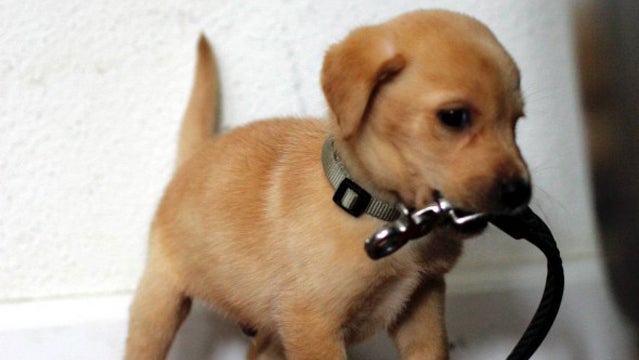Photographers already know this one. If you want to take a picture of wildlife doing something interesting, you’re going to have to wait around and snap the shutter at just the right moment. Capturing your pup’s behavior works the same way: Be ready when your pup does something good, mark the behavior with your bridge, and reward generously. Then wait to see if your pup offers the behavior again and re-reward.
The Ultimate �����ԹϺ��� Companion
All you need to know about going wild with man’s best friend.Mike Stewart of Wildrose Kennels uses this one to teach young pups to go to the bathroom on command, but it can be used for any behavior. Best of all, this exercise gives the pup a mind to offer different behaviors to see what brings a reward. A pup that offers behaviors is much easier to train than one that needs to be lured or forced.
Here’s how I started my dog Cooper on sit:
1. I know that if I stand over his puppy pen long enough, he’ll stop standing on his hind legs howling and eventually drop his butt to the ground—maybe for just a second to lick himself before starting to howl again.
2. At that instant of butt-hit-the-ground, I mark the behavior, praise him, give him a tiny nibble of liver, then offer a couple of pets.
3. To mark behaviors at this early aquisition stage, I like the clicker because, unlike my voice, it’s sharp, quick, and never changes tone. Once the behavior is learned, I immediately switch to a verbal bridge—“good”—which I can project into the field.
4. The second time I stood over Cooper’s pen and waited, the sit came a little sooner and with a bit more deliberation. I repeated the mark/praise/treat/pet/routine. There are actually a few things going on here: 1. I’m marking the behavior and teaching him that when his butt hits the ground, he’ll get a reward. For a smart dog, that realization that butt-hit-ground is like a treat lever is mana from heaven. 2. I’m conditioning the bridge–first the clicker*–then my voice as a significant sound that means the reward is coming. Eventually that sound alone will become a reward. 3. Cooper is learning through association that verbal praise accompanies good things like petting and liver snacks. If we’re going to end up with a dog that works, runs, and plays with us off lead and without an e-collar, this is where it all begins. 4. You’re teaching him that crying and yelping doesn’t buy him anything, but that sitting calmly does.
5. Once he’s consistently sitting when you stand over him, you can add the sit cue. Since you already know he’s going to sit.
6. Now, when we add the slip lede at eight weeks or so, we’ve already got a dog that knows what he’s supposed to do. And if he ignores you, you’re adding pressure from the lede becomes a reminder. You may discover you don’t even need to add pressure.
TEACHING YOUR PUP TO PEE ON COMMAND
1. This one is breathtakingly easy. Every time you take your pup out of his crate after a nap and bring him outside, you know he’s going to pee almost immediately. So just add your cue as soon as you put him down.
2. Use this on walks and especially when you’re traveling.
*Mike and his Wildrose trainers don’t use clickers, but go straight to the verbal bridge. They’re also full-time pros with great timing and consistency. Whether you use a clicker on the way to a verbal bridge or just start with your voice isn’t as important as your being consistent and building the bridge as a long-term habit.
This article originally appeared on �����ԹϺ��� K9, the former dog blog of �����ԹϺ��� magazine, on April 28, 2009.


